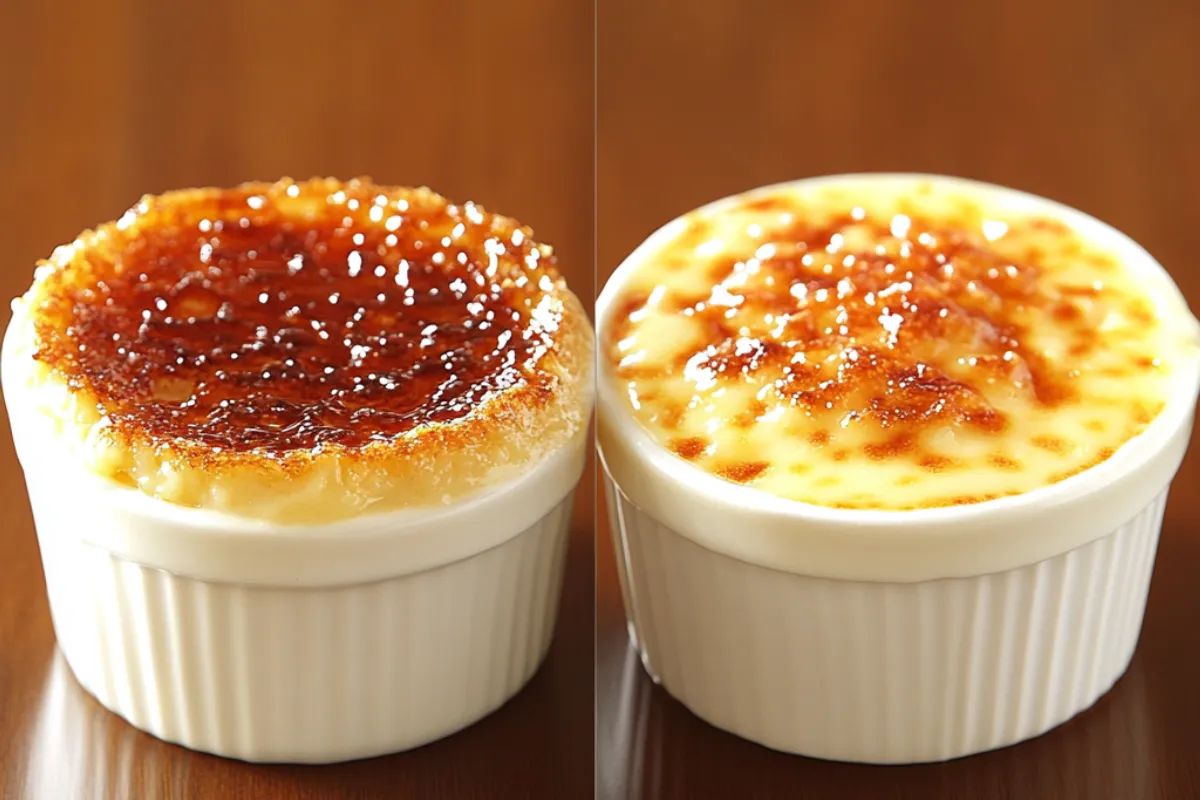Crème brûlée and custard are two iconic desserts that share a rich, creamy base but offer distinct culinary experiences. While they are both egg-based delights, they differ in texture, flavor, and presentation. This article delves deep into these differences, exploring the history, preparation methods, and unique qualities that make each dessert a favorite among food lovers. We’ll also address common questions and provide insights into when to serve each of these delicious treats.
Introduction to Crème Brûlée and Custard
People have cherished crème brûlée and custard as desserts with a long history in French cuisine. Both desserts use a base of eggs, cream, and sugar. However, their differences are just as significant as their similarities. For example, crème brûlée is famous for its caramelized sugar topping that cracks when you tap it with a spoon. In contrast, custard is more versatile and can be enjoyed in many different forms.
Key Differences:
- Crème brûlée is a type of custard with a caramelized sugar crust.
- Custard is a broader category of desserts with varying textures and flavors.
To fully understand these desserts, it’s essential to explore their origins and how they’ve evolved over time.
History and Origins of Crème Brûlée and Custard
Crème Brûlée
Crème brûlée, which means “burnt cream” in French, originated in 17th-century France. It quickly became popular in the courts of King Louis XIV, symbolizing culinary sophistication. The dessert is thought to have been inspired by crema catalana, a similar Spanish dessert. The signature feature of crème brûlée is its caramelized sugar topping, usually created using a culinary torch.
Custard
Custard, on the other hand, traces its roots back to ancient Rome, where it was made with eggs and milk. Over time, custard spread across Europe and became a staple in many forms, from the delicate crème anglaise in France to the hearty baked custards in Britain. Its versatility led to numerous regional variations, each with its own unique characteristics.
External Resources:
- Learn more about the History of Crème Brûlée and how it became a dessert staple.
Key Historical Points:
- Crème brûlée: Originated in 17th-century France, inspired by Spanish crema catalana.
- Custard: Ancient Roman origins, evolved across Europe with various regional adaptations.
Ingredients and Preparation of Crème Brûlée
Crème brûlée is a luxurious dessert that requires only a few ingredients, but its preparation requires careful attention to detail to achieve the perfect texture.
Key Ingredients:
- Egg yolks
- Sugar
- Heavy cream
- Vanilla bean or extract
Preparation Process:
- Infusing Cream: The heavy cream is infused with vanilla to enhance the flavor.
- Tempering the Eggs: The egg yolks are gently mixed with sugar, and then the warm cream is slowly added to avoid curdling.
- Baking: The custard mixture is poured into ramekins and baked in a water bath to ensure even cooking.
- Caramelizing the Sugar: Once cooled, a layer of sugar is sprinkled on top and caramelized using a torch to create the signature crust.
External Resources:
- Discover how to achieve the perfect caramelized crust with this guide on How to Caramelize Sugar.
Ingredients and Preparation of Custard
Custard is a more general term that encompasses a variety of desserts. The ingredients and methods can vary based on the type of custard, but the basic principles stay the same.
Key Ingredients:
- Eggs (whole eggs or yolks)
- Milk or cream
- Sugar
- Optional: Vanilla, cinnamon, nutmeg, or other flavorings
Preparation Methods:
- Basic Custard: Milk is heated until almost boiling, then mixed with beaten eggs and sugar. The mixture is gently cooked over low heat or baked until it thickens.
- Baked Custard: The custard is poured into a dish and baked until set. It can be served warm or chilled.
- Stirred Custard: Also called crème anglaise, this custard is cooked on the stovetop and stirred continuously to prevent curdling.
Variations:
- Flavors: Custard can be flavored with vanilla, chocolate, fruit, or spices to create a wide range of desserts.
- Textures: Depending on the cooking method, custard can be light and silky or dense and firm.
Texture and Consistency Comparison
The texture and consistency of crème brûlée and custard are where these two desserts truly differ.
Crème Brûlée:
- Texture: Luxuriously smooth and creamy, with a dense consistency.
- Unique Element: The crisp caramelized sugar topping adds a contrasting crunch.
Custard:
- Texture: Varies depending on preparation, but generally softer and lighter than crème brûlée.
- Consistency: Can range from silky and smooth (crème anglaise) to firm and sliceable (baked custard).
Key Takeaway:
- Crème brûlée is richer and denser, with a contrasting texture from the caramelized top.
- Custard provides more variety in texture based on how it’s prepared.
Flavor Profiles: Contrasts and Similarities
When it comes to flavor, both crème brûlée and custard share a rich, eggy base, but their flavor profiles can vary significantly based on the ingredients and preparation methods used.
Crème Brûlée:
- Primary Flavor: Vanilla is the dominant flavor, enhanced by the caramelized sugar’s bittersweet notes.
- Texture-Flavor Interaction: The smooth custard contrasts with the crunchy topping, creating a dynamic flavor experience.
Custard:
- Versatile Flavor: Custard can be flavored with vanilla, chocolate, fruit, or spices, making it adaptable to different tastes.
- Subtle Sweetness: Custard is typically less sweet than crème brûlée, allowing the natural flavors of the eggs and milk to shine.
Key Flavor Notes:
- Crème brûlée offers a rich vanilla flavor with a sweet, caramelized finish.
- Custard is versatile, with the potential for a wide range of flavors.
Serving and Presentation Variations
Both crème brûlée and custard offer numerous opportunities for creative presentation, making them versatile desserts for any occasion.
Crème Brûlée:
- Traditional Serving: In individual ramekins, topped with caramelized sugar.
- Garnishes: Fresh berries, mint leaves, or a dollop of whipped cream.
- Presentation Tip: Serve with a spoon to crack the sugar crust for maximum enjoyment.
Custard:
- Serving Styles: Can be served in decorative molds, baked in a pie crust, or poured into a parfait glass.
- Garnishes: Cinnamon, chocolate sauce, or a dusting of cocoa powder.
- Versatility: Custard can be served warm, chilled, or even frozen.
Key Presentation Tips:
- Crème brûlée shines in individual servings with a dramatic sugar crust.
- Custard offers flexibility in presentation, making it suitable for both casual and formal settings.
Popular Variations and Regional Differences
Crème brûlée and custard have inspired countless variations around the world, each adding its own twist to these classic desserts.
Crème Brûlée Variations:
- Flavors: Chocolate, lavender, citrus zest, or infused with liqueurs like Grand Marnier.
- Regional Influence: Some variations may incorporate local ingredients, such as matcha in Japan or coconut in tropical regions.
Custard Variations:
- British Custard: Often served alongside traditional puddings like bread and butter pudding or spotted dick.
- Spanish Crema Catalana: A custard similar to crème brûlée, but flavored with cinnamon and lemon zest.
- French Crème Anglaise: A lighter, pouring custard often used as a sauce for desserts.
Key Variation Insights:
- Crème brûlée is adaptable with various flavor infusions.
- Custard showcases regional differences, with each culture adding its unique twist.
Serving Recommendations: When to Serve Crème Brûlée or Custard
Both crème brûlée and custard are popular dessert choices, but each is better suited to different occasions.
Crème Brûlée:
- Best Served: As an elegant dessert for formal dinners or special occasions.
- Occasions: Ideal for romantic dinners, holiday feasts, or any event where you want to impress.
Custard:
- Versatility: Perfect for any time of day, from brunch to a casual dinner.
- Occasions: Great for family gatherings, picnics, or as a comforting treat after a simple meal.
Key Serving Tips:
- Serve crème brûlée when you want to make a statement with a rich, indulgent dessert.
- Serve custard for a versatile, crowd-pleasing option that can be dressed up or down.
FAQs
What Is the Main Difference Between Crème Brûlée and Custard?
The main difference lies in the caramelized sugar topping of crème brûlée, which adds a crunchy texture and deeper sweetness. On the other hand, custard can have a more varied texture and flavor, depending on the preparation method.
Are the Ingredients Used in Crème Brûlée the Same as Those in Custard?
The ingredients are similar, but crème brûlée typically uses heavy cream and more egg yolks, resulting in a richer, denser dessert. Custard can use either milk or cream and may include whole eggs, resulting in a lighter texture.
How Do the Textures of Crème Brûlée and Custard Differ?
Crème brûlée has a smooth, dense texture with a contrasting crisp top layer, while custard varies from light and silky to firm, depending on the preparation method.
Can Both Crème Brûlée and Custard Be Made with Similar Cooking Techniques?
Yes, both desserts involve heating a mixture of cream and eggs until they thicken, but crème brûlée requires an additional step of caramelizing sugar on top.
Are There Any Variations in Flavors When Comparing Crème Brûlée and Custard?
While both can include vanilla, crème brûlée often has a stronger vanilla flavor and features the signature caramelized sugar topping. Custard, however, offers a broader range of flavors, from chocolate to fruit.
Conclusion and Final Thoughts
In the world of indulgent desserts, choosing between crème brûlée and custard is a delightful dilemma. Both desserts offer rich, creamy bases; however, their distinct preparation methods and textural differences make them unique. Whether you prefer the crisp, caramelized crust of crème brûlée or the versatile, silky smoothness of custard, each dessert brings a touch of sophistication and sweetness to the table.
As culinary enthusiasts keep exploring these classic treats, it’s evident that both crème brûlée and custard have secured their place among the great desserts. Whether you’re indulging in the rich flavors of a perfectly prepared crème brûlée or savoring the comforting taste of a classic custard, you’re sure to have a truly satisfying experience.

